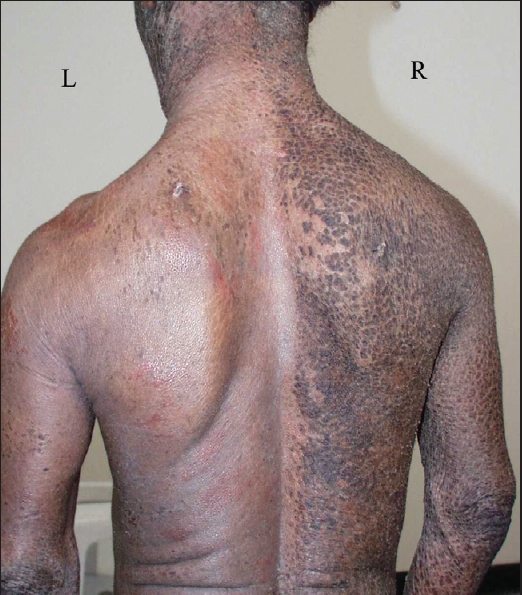Translate this page into:
Effect of tazarotene on ichthyosiform erythroderma of Tay's syndrome
Correspondence Address:
C R Srinivas
Department of Dermatology, PSG Hospitals, Peelamedu, Coimbatore - 641 004, Tamil Nadu
India
| How to cite this article: Varghese VS, Rai R, Sundaram SV, Prabhu KS, Srinivas C R. Effect of tazarotene on ichthyosiform erythroderma of Tay's syndrome. Indian J Dermatol Venereol Leprol 2007;73:126-127 |
 |
| Marked reduction of erythema and scaling over the left site treated with tazarotene (post-treatment) |
 |
| Marked reduction of erythema and scaling over the left site treated with tazarotene (post-treatment) |
 |
| Ichthyosiform erythroderma in a patient of Tay�s syndrome (pre-treatment) |
 |
| Ichthyosiform erythroderma in a patient of Tay�s syndrome (pre-treatment) |
Sir,
Tay′s syndrome, a rare autosomal recessive disorder reported by Dr. Tay Chong Hai in Singapore in the year 1969, is characterized by icthyosiform erythroderma, trichothiodystrophy, brittle hair and nails, intellectual impairment, decreased fertility, short stature, progeria-like facies and photosensitivity. [1] Emollients are helpful in improving skin discomfort and suppleness. Retinoid therapy and keratolytics have been tried with disappointing results. [1] We report control of ichthyosis in a case of Tay′s syndrome by topical application of tazarotene.
A 17-year-old male presented with trichorrhexis nodosa (diagnosed with light microscopy), ichthyosiform erythroderma [Figure - 1], ectropion, reduced eyelashes, onychodystrophy, short stature, photosensitivity and reduced sweating and was diagnosed as Tay′s syndrome.
A biopsy showed hyperkeratosis, hypergranulosis, mild acanthosis and follicular plugging over the treated site and the site treated with liquid paraffin showed hyperkeratosis, parakeratosis, acanthosis, neutrophil collections in the stratum corneum and neutrophil infiltrate around the blood vessels in the superficial dermis.
He was initially treated with isotretinoin 20 mg for one month and responded partially to the treatment but was unwilling to continue because of the possible side-effects. He was then advised to apply tazarotene 0.1% twice daily on the left side of the entire back and liquid paraffin twice daily on the right side of the back. In two weeks significant improvement with reduction in erythema and scaling was seen on the tazarotene treated site as compared to the site treated with liquid paraffin [Figure - 2]. Since 0.1% tazarotene although effective resulted in a few areas of irritation 0.05% was tried but was less effective. The patient and the parents then decided to apply tazarotene 0.1% over the face only and this resulted in clearing of face lesions but with relapse of lesions over the trunk.
Tazarotene is used in the treatment of psoriasis [2] and acne vulgaris. [3] In single cases or small series, useful responses to topical application of tazarotene have been reported in lamellar ichthyosis [4],[5],[6] X-linked ichthyosis and ichthyosis vulgaris [5] and ichthyosis bullosa of Siemens. [7] Tazarotene is a prodrug that is hydrolyzed rapidly in tissues to the active metabolite termed tazarotenic acid. Tazarotenic acid has a high affinity to the RAR-g nuclear receptor that is the predominant receptor present in the epidermis. Tazarotenic acid also binds to RAR-a and RAR-β not to RXRs. By binding to the various RARs, tazarotenic acid modulates the expression of retinoid responsive genes, including those that regulate cell proliferation, cell differentiation and inflammation. Thus the topical application of tazarotene resulted in decrease of erythema and scaling.
Since the patient has congenital ichthyosis, he was advised to apply tazarotene daily, as alternate day-tapering resulted in relapse. We recommend the use of topical tazarotene as a safe alternative in the treatment of ichthyosis associated with Tay′s syndrome.
| 1. |
Judge MR, Mclean WHI, Munro CS. Congenital ichthyosis. In: Burns T Breathnach S, Neilcox, Griffiths C, editors. Rook's Textbook of Dermatology. 7 th ed. Blackwell Scientific Publications: Oxford; 2004. p. 34-41.
th ed. Blackwell Scientific Publications: Oxford; 2004. p. 34-41.'>[Google Scholar]
|
| 2. |
Weinstein GD, Koo JY, Krueger GG, Lebwohl MG, Lowe NJ, Menter MA, et al . Tazarotene cream in the treatment of psoriasis: Two multicenter, double-blind, randomized, vehicle-controlled studies of the safety and efficacy of tazarotene creams 0.05% and 0.1% applied once daily for 12 weeks. J Am Acad Dermatol 2003;48:760-7.
[Google Scholar]
|
| 3. |
Bershad S, Kranjac Singer G, Parente JE, Tan MH, Sherer DW, Persaud AN, et al . Successful treatment of acne vulgaris using a new method: Results of a randomized vehicle-controlled trial of short-contact therapy with 0.1% tazarotene gel. Arch Dermatol 2002;138:481-9.
[Google Scholar]
|
| 4. |
Stege H, Hofmann B, Ruzicka T, Lehmann P. Topical application of tazarotene in the treatment of non-erythrodermic lamellar ichthyosis. Arch Dermatol 1998;134:640.
[Google Scholar]
|
| 5. |
Marulli GC, Campione E, Chimenti MS, Terrinoni A, Melino G, Bianchi L. Type I lamellar ichthyosis improved by tazarotene 0.1% gel. Clin Exp Dermatol 2003;28:391-3.
[Google Scholar]
|
| 6. |
Hofmann B, Stege H, Ruzicka T, Lehmann P. Effect of topical tazarotene in the treatment of congenital ichthyoses. Br J Dermatol 1999;141:642-6.
[Google Scholar]
|
| 7. |
Rajiv S, Rakhesh SV. Ichthyosis bullosa of Siemens: Response to topical tazarotene. Indian J Dermatol Venerol Leprol 2006;72:43-6.
[Google Scholar]
|
Fulltext Views
4,461
PDF downloads
2,631





